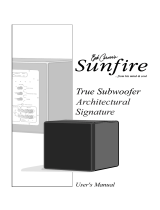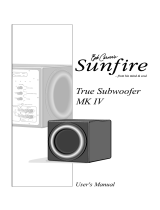Page is loading ...

Owner’s Manual
Seismix 3 and Seismix 5

The Seismix 3 and Seismix 5 active subwoofers will complement existing Stereo or Home
Theatre systems producing an increase in low frequency performance for a deep experience.
The Seismix 3 and Seismix 5 are compatible with a variety of small to large sized, sealed
or vented, main/satellite speakers.
Your subwoofer contains an amplier of the highest electronic standards. Krix have introduced
In Circuit Serial Programming (ICSP), meaning the microcontroller within the amplier can be
upgraded via the serial interface located internally on the amplier module. This means as
future features are developed your subwoofer can be upgraded. You would simply need
to return the amplier module to Krix, where the upgrade would take place.
Congratulations on choosing Krix
connection
1. Ensure the main power switch is off
and connect the mains power cord.
2. There are two methods which you can use
to connect the Seismix subwoofer, either
via the line level inputs which will require
your stereo amplier / AV receiver to have
a subwoofer output facility (mono or stereo
outputs) or via the speaker level inputs.
Method 1: Line Level Connections
It is recommended that you use LineLevel
connections for home theatre applications.
Connect the SUB OUT socket(s) on your
AV receiver to the LineLevel input(s)
which are a pair of RCA sockets located
in the middle of the rear subwoofer panel
(see gure 1). The SUB OUT socket on your
AV receiver is usually mono which can be
connected to the Seismix with one lead
to the ‘Left (mono)’ input. If your AV receiver
has stereo SUB OUT sockets then use dual
leads, connecting these to the ‘Left and
Right’ inputs. Refer to gure 2 for connection
using LineLevel signal.
Method 2: Speaker Level Connections
For stereo applications connect the Speaker
Level outputs on your main amplier to the
SpeakerLevel inputs on the rear panel of
the Seismix (see gure 1). Then connect
the SpeakerLevel outputs on the rear panel
of the Seismix to each of your left and right
speakers. Be sure to maintain correct phasing
for each set of speaker leads, red (positive +)
to (+) and black (negative -) to (-). Refer
to gure 3 for connection using Speaker
Level signal.
3. Before turning the Seismix on, ensure the
volume control is turned down and set the
LowPass(Hz) control to the middle position
(see gure 1). Turn on the unit with the
power switch located at the bottom of the
rear panel, the subwoofer will activate and
the blue Power/Standby LED will light up.
Begin by playing music with bass content
and slowly increase the volume dial on the
subwoofer to a moderate level.
Figure 1 Back panel of subwoofer
Volume Control
Low Pass Control
Speaker Level
Input/Outputs
Line Level Inputs
Mains Power Switch
Main Stereo Amplier
To main stereo speakers
Figure 3 Connection using SpeakerLevel signal
To main
stereo speakers
Main AV Receiver
Figure 2 Connection using LineLevel signal
If only a single or mono sub-out
exists, then plug that into the left
Line Level input labelled mono
From pre-out
or sub-out
+ - - +
+ - - +

Warning:itisrecommendedthattheunit
isturnedoffatthemainspowerifbeing
leftunattendedforanyextendedperiods.
Standby Mode
Krix have included an energy saving device
when the unit is in Standby mode, meaning
the Seismix draws a meagre 3 watts (costing
approximately AUD$5.00 for 1 year to run).
Symetrix Vent
The Seismix subwoofer enclosure features
Symetrix bass reex venting, with the vent
exhibiting the same are radius both internally
and externally. This lowers subwoofer distortion
and serves to reduce vent turbulence or
“chufng” at high drive levels.
Clipping Protection
There are several layers of protection in
the electronics of the Seismix to prevent
clipping damage.
Opto-compressor: When faced with a signal
peak which is in excess of what the Seismix
can accurately reproduce, a compressor circuit
activates to reduce the level of the signal once
it passes the preset threshold. This permits the
Seismix to perform at high level with only a
mild reduction in the signal’s dynamic content.
Soft Limiter: If severe overdriving of the
amplier continues to place a strain on the
compressor circuit, a soft limiting circuit
activates. The soft limiter circuit monitors
the Seismix’s amplier power supply voltage
and prevents a direct current (DC) signal from
reaching the bass driver, causing damage.
features
Automatic on / off circuit
Standby Mode
Symetrix Vent
Clipping protection
- Opto-compressor with fast attack
to prevent overload
- Soft limiting to prevent amplier clipping
Multi-layered fault protection
- DC Detect Sensor
- Thermal Sensor
- Mains Fuse
Electronic ltering
- Earth lift switch to eliminate ground loops
- 2
nd
order low pass lter adjustable
from 60Hz to 150Hz
- Adjustable Hi / Lo gain setting
- 0°/180° phase switch
- Fixed 2
nd
order high pass lter to
reduce driver excursion below 30Hz
Independent adjustable gain control
Heavy duty, high efciency long throw
paper cone drivers designed for high level
sound reinforcement
High current low noise amplier
Automatic On / Off Circuit
For the auto circuit function to operate, the
power switch on the back of the subwoofer
needs to be left on (and can be done so safely,
see gure 1). The AutoCircuit monitors both
the speaker level or line level inputs and powers
the amplier in the subwoofer. When a signal
is present the blue Power/Standby LED at
the top of the rear panel will remain lit. When
a signal is not present, the power will remain
on for approximately 15 minutes and will then
automatically switch itself to standby mode.
In standby mode the blue Power/Standby
LED will ash.
Fault Protection
The mains fuse protects against any
major electrical faults or short circuits
and incorporates an inrush current limiter
to eliminate power surges when using the
main on / off switch. The Seismix uses an
ATMEL MEGA16
®
microcontroller which is
the integrated circuit responsible for the
advanced fault protection features of the
Seismix amplier. A microcontroller is a small
single chip computer optimised for hardware
control that runs a program stored in ash
memory on the chip. The construction of
the Seismix amplier utilises surface mount
technology (SMT), which results in a more
compact design, high resistance to mechanical
vibration and higher circuit performance. The
lter capacitor bank present in the Seismix
amplier features many low Equivalent Series
Resistance (ESR) capacitors allowing lower
supply impedance and greater instantaneous
power delivery to the loudspeaker load.
DC Detect Sensor: Clipping is severe square
wave distortion that contains a direct
current (DC) component often responsible
for loudspeaker damage. In the event of an
abnormal function the amplier will not only
shut down, but all LED’s will ash. If this
happens turn the subwoofer off and contact
your nearest Krix retailer for further assistance.
Thermal Sensor: The Seismix has a generously
sized heat sink, permitting normal operation
in high ambient temperatures. A thermal
sensor internally connected to the heat
sink is monitored every 20 seconds by the
microcontroller. In the unlikely event that
the amplier’s temperature reaches above
65 degrees celsius the microcontroller
will reduce output by 1dB every 20 seconds
until the temperature is 65 degrees celsius
or below. The microcontroller will return
the amplier to normal operating settings
by increasing the output by 1dB every
20 seconds.

+
+
= =
= =
2
1
0
-1
-2
2
1
0
-1
-2
2
1
0
-1
-2
2
1
0
-1
-2
2
1
0
-1
-2
2
1
0
-1
-2
Earth Lift
The EarthLift button ensures the Seismix
can be connected to a wide range of stereo
ampliers / AV receivers. Should a humming
noise be evident when the Seismix is connected,
push the EarthLift button (see gure 1) which
interrupts the current that may be circulating from
the subwoofer’s signal ground through the mains
earth wiring (see gure 4). Note: The EarthLift
button does not break the mains earth connection
to the subwoofer, only the connection between
the subwoofer’s signal ground and the mains
earth. To guard against electric shock NEVER
disconnect the mains earth from any appliance.
Low Pass (Hz)
The LowPass control (see gure 1) adjusts
the total bass content from the Seismix. This
control allows you to adjust the upper limit of the
Seismix’s frequency range between 60 –150 Hz.
The higher the selection, the broader the range
of bass information heard. This setting can be
adjusted for personal taste and integration with
your main speakers.
Hi / Lo Gain
The Hi/LoGain button (see gure 1) is
positioned below the blue Power / Standby
LED, this button allows you to increase or
decrease the sensitivity of the subwoofer
without adjusting other settings. In the ’Lo’
gain position, a much higher input signal is
required, and you will need to increase the
main volume control to reach maximum output.
In the ’Hi’ gain position the output of the
subwoofer is increased by approximately 20dB,
requiring a lower input signal, meaning you will
not need to increase the main volume control
to achieve the same amount of output.
Phase
Signal phase can be left at '0°', or shifted
180° (inverted), by pressing the Phase button
(see gure 1). This applies to the output of
the subwoofer compared to its input.
To get the most from all of your speakers they
must be operating in Phase. That is the signals
must all be positive going or negative going
simultaneously. If this is not the case and one
signal is positive going and the other is negative
going the result will be a cancellation of signal
and the sound at those particular frequencies
will be perceived as quite 'empty' sounding
and lacking potential impact.
The setting of the Phase button (ie. 0° or
180°) and the resulting sound is dependant
on where the subwoofer is positioned in
relation to the main speakers. The best way
to nd the correct setting is through trial and
error during set up by comparative listening
tests. In most cases the effect will be subtle
and there won't be a complete lack of bass.
If no difference can be heard, the position
of the button is not crucial.
The effect of phase can best be shown with
the representation of a sine wave (see gure
5). The effect shown in the lower diagram is
with the signals 'out of phase' and this can be
rectied by changing the position of the Phase
button. This will invert the negative going
signal and the result will be the same as
the rst, 'In Phase', example.
Line Level Inputs
Line level inputs (see gure 1 or 2) need to
be connected to the ‘PRE OUT’ or 'SUB OUT’
from your stereo amplier / AV receiver.
The line level stereo input performs a summing
function adding the left and right signals where
applicable, to give a mono (L+R) signal. This
mono signal is ltered and then amplied
before being sent to the subwoofer driver.
Speaker Level Inputs
The speaker level stereo inputs combine
the signal going to the main left and right
speakers providing a mono (L+R) signal to
the subwoofer driver. This mono signal is
ltered and then amplied in the same
way as the line level input signal before being
sent to the loudspeaker. Two pairs of terminals
are provided so that the speaker level signals
can “pass through” the subwoofer on the way
to the main speakers (see gure 1 or 3).
Figure 4 Earth lift button
Mains power outlets
Subwoofer
Signal connection
Earth lift button
Circulating ground currents
Denotes signal ground
Denotes chassis Earth
Receiver / Amplier
Figure 5 Phase
Positive going
(No output)
180° out
of phase
Negative going
In Phase

Volume
The volume control will adjust the volume
of the subwoofer only. The control can be
set for the subtleties of the lower octaves
in musical performances or increased for
the earth shattering explosions and effects
on movie sound tracks. The volume control
on your main amplier / AV receiver controls
volume for your overall system (see gure 1).
positioning
The procedure for setting up any subwoofer
can be time consuming, requiring numerous
minor adjustments to get the desired result.
There is no denitive 'correct' way to set up a
subwoofer. Given different listening environments
different people’s tastes and different speakers,
there are a number of variables that have to be
taken into consideration.
It is up to the individual listener to adjust
the Seismix for the character and strength
of bass that is preferred for whatever type
of source material is being reproduced.
It is benecial to select music that is familiar
to you when carrying out listening tests and
setting up procedures and as a suggestion
play recordings that use wooden instruments
such as acoustic guitars, oboes, cello etc.
These instruments exhibit a strong resonant
characteristic in the low to mid bass region
and will highlight unpleasant ‘woody’ or ‘chesty’
sound qualities suggesting there is too much
overlap in the bass information between the
subwoofer and main speakers.
To ne tune the integration of the Seismix into
your Hi- system, start with both the LowPass
(Hz) and Volume at the middle setting. Gradually
adjust the setting of the LowPass(Hz) either
up or down (see gure 1). This will vary the
amount of overlap from the sub to the main
speakers and increase or decrease the level at
those frequencies. The effect is a strengthening
or weakening of the upper bass region. You might
reach a point where the sound develops a 'boxy'
or 'chesty' quality which is not desirable. This
could indicate there is too much overlap from
the sub to the main speakers and is remedied
by turning the LowPass(Hz) back. Adjust the
Volume level to suit your personal taste.
If you have any queries regarding the Seismix, the set up procedure or any other KRIX
product, please contact your nearest Krix retailer or Krix direct. Contact details are on
the back cover of this booklet.
warranty
5 years warranty applies to the cabinet and speaker
1 year warranty applies to the amplier and related internal electronics
(Refer to the details on the warranty card supplied)
trouble shooting
Symptom Probable Cause Treatment
No noise from the
subwoofer when
main power is on
Auto switch circuit has not
operated due to no signal
Volume turned down
Signal has no bass content
Play source material and
gradually increase the volume
from the main Hi- amplier
Increase Volume on the sub
Play source material with
sufcient bass content
Very little bass coming
from the subwoofer
Apart from the source
material having little bass
content, the settings on the
sub may need adjustment
Increase setting of the
LowPass(Hz) control
Try changing position of
the Phase button
Increase Volume on the sub
Change gain button from
‘Lo’ to ‘Hi’
Bass content is
too strong and
uncomfortable
to listen to
Settings on the subwoofer
may need adjustment
Decrease the setting of
the LowPass(Hz) control
Decrease the Volume on
the subwoofer
Subwoofer emits
a humming sound
Current may be circulating
from the subwoofer’s signal
ground through the mains
earth wiring.
Activate the EarthLift by
pushing the button which
will break the current loop

Seismix 3: specications
Drivers
Bass Driver Nominal 255mm (10”) diameter paper cone driver developed for
high level, low frequency reinforcement
Electronics
Amplier Power 200 watts RMS into the nominal 4 ohm driver
Maximum instantaneous power 400 watts
Amplier S/N >70dB
Distortion - Input to Speaker <0.1% - @ 80 watts RMS
Line Level Inputs Left Input (mono) Lo – 900mV RMS for maximum output
Hi – 100mV RMS
Left + Right Input (stereo) Lo – 450mV RMS for maximum output
Hi – 50mV RMS
General
Frequency Range 22Hz - 150Hz (-6dB) in room response
Output 120dB maximum SPL in room response
Auto Power On / Off 15 minute delay before switching to standby after no input signal
Phase Select 0° or 180° (relative to input signal)
Cabinet
Enclosure Type Bass reex, front vented
Dimensions 415mm high x 360mm wide x 390mm deep
Material 17mm MDF
Finish Vinyl or lacquered timber veneer
Weight 18kg
Due to continued development specications may change without notice

Seismix 5: specications
Drivers
Bass Driver Nominal 305mm (12”) diameter paper cone driver developed for
high level, low frequency reinforcement and large linear cone travel
Electronics
Amplier Power 400 watts RMS into the nominal 4 ohm driver
Maximum instantaneous power 800 watts
Amplier S/N >70dB
Distortion - Input to Speaker <0.1% - @ 80 watts RMS
Line Level Inputs Left Input (mono) Lo – 900mV RMS for maximum output
Hi – 100mV RMS
Left + Right Input (stereo) Lo – 450mV RMS for maximum output
Hi – 50mV RMS
General
Frequency Range 16Hz - 150Hz (-6dB) in room response
Output 122dB maximum SPL in room response
Auto Power On / Off 15 minute delay before switching to standby after no input signal
Phase Select 0° or 180° (relative to input signal)
Cabinet
Enclosure Type Bass reex, front vented
Dimensions 460mm high x 395mm wide x 440mm deep
Material 19mm and 25mm MDF
Finish Vinyl or lacquered timber veneer
Weight 30kg
Due to continued development specications may change without notice

krix.com
Krix Loudspeakers Pty Ltd
14 Chapman Road
Hackham SA 5163
Australia
T 61 8 8384 3433
F 61 8 8384 3419
/






